Borschevik is a poisonous plant brought from the Caucasus and spread throughout Russia. Initially, people had high hopes for him, thinking of using juicy rapidly growing grass as a silage culture, but it soon became clear that the hogweed was completely unsuitable for this. He managed to grow so quickly that it became almost impossible to get rid of him. If a hogweed appeared on the site, it should be removed immediately. This article will talk about the danger of plants and methods of combating it.
The history of the cultivation of hogweed
Once an ordinary hogweed was imported from the Caucasus, where plant crops are distinguished by extraordinary endurance and are able to survive even in a harsh climate. Later, by order of Stalin, another species was brought to the territory of modern Russia - Sosnovsky Borshshik, characterized by colossal dimensions and survivability. It was planned to be grown as a silo culture, but all the experiments failed. It turned out that the feeding of the livestock livestock gives an unpleasant specific taste of milk and meat, but also negatively affects the offspring.
In addition, large leaves in contact with human skin can cause severe harm, causing a chemical burn. The breeding of hogweed was immediately stopped, but the plant differed not only in large sizes and endurance, but also by the enormous rate of reproduction. Borshshik matures very quickly and leaves seeds at this place, which, in turn, also germinate quickly, and the cycle is repeated again.
If a hogweed appeared on the site, then very soon it will replace all natural vegetation and “crush” any fruiting crops. It was he who caused the agricultural crisis in the 90s, and since then many methods of combating this pest have been tried.
Today in the territory of the Russian Federation you can find several types of hogweed, one of which in Rus' was used to prepare borsch (hence the name). Borshnevik is a furry, which can be used, which can be used for therapeutic purposes and Siberian (edible). An ordinary hogweed is a good cattle food and does not affect the offspring and taste of milk. The reputation of this plant is overshadowed by only two species - marmage of Mantegazzi and Sosnovsky. These are malicious weeds that can not only eradicate all the useful vegetation in the district, but also cause serious harm to health up to death.
An interesting fact: at one time, the Roman thinker Pliny called Borshshik Heracles because of his unusually large size.
The appearance of the hogweed
In total, there are 34 species in the family of hogweeds distributed across the territory of the former USSR, and in the world there are more than 70 in the world. In Russia, only 15 of them grow. Some varieties can reach incredibly large sizes-up to 4.5-5 m from umbrellas with a diameter of about 1.5 m! Having met such a fantastic plant, there is a desire to touch a thick stem, to disrupt the inflorescence or take a picture with it, but this is not worth doing.
Despite the fact that only a few types of hogweed are considered very poisonous and life -threatening, it is they who most often come across in the middle latitudes and reach similar sizes. So, how to recognize dangerous varieties of plants in order to stay away from them?
Borshshik appears in the spring one of the first and immediately spreads the large leaves-lobuses on the ground, resembling a bear paw-sinewy, with small villi and pointed tips. The leaves can be peri-oriented or triplets of light green, yellowish or brown green.
The stem of the hogweed is thick, sinewy and has grooves. It goes underground with an equally powerful horse, which can reach a length of 2 m, and in thickness - up to 15 cm. From one root, several shoots usually grow at once.
At the end of May and early June, horsesholic is thoroughly growing, forming thick impassable thickets. Flowering takes place from mid -July to mid -August. The hogweed blooms, to say, impressive - large baskets are covered with thousands of small white flowers, around which bees are constantly swarming (the plant is an excellent honey plant).
From the end of July to mid-September, seeds ripen, and the baskets become brown-brown. The fruits of the hogweed are surprisingly small and resemble the seeds of dill. You can find out where the thickets of this weed is located not only in the warm season. Even in winter, when everything is covered with snow, huge dried stems with umbrellas rise above the ground, so you can remember the place and not come there in the summer for a picnic.
What is the dangerous plant
When Sosnovsky’s hogweed spread beyond experimental cultivator divisions, people faced a serious problem - it turned out to be extremely difficult to get it out, and during an attempt to get rid of weeds it was possible to get serious damage. The extermination of the hogweed began to resemble the most natural military operations with injuries, burns and even deaths.
Many underestimate the damage from random and short contact with the hogweed, believing that he is akin to nettle burn. In addition, it is difficult for unprofessional to distinguish toxic and safe varieties of plants. Borshshik causes harm not only in a contact method, but is also a powerful breathing allergen. The plant contains substances that immediately instantly increase the susceptibility of the skin to ultraviolet radiation, causing severe burns. That is why it is especially dangerous to “burn” the hogweed on a sunny day, and even a layer of thin fabric of a summer dress or trousers will not become an obstacle.
To get an injury, only a short light touch to the juice distinguished from biases. How does this happen if you do not specifically break the plant? A sheet or short stalks of hogweed can break even from a slight press while walking through thickets, so you should take measures immediately as soon as you notice this weed on your site. Even if a small crowd of hogweed is located in the “noe” territory not far from your home, there are no doubt that very soon the thickets are reached your land.
Burns from the hogweed may not appear immediately. Can go from an hour to several days.
Determine that you burned precisely by hogweed by the following signs:
- strong redness;
- burning and light itching of the injured area;
- redness is replaced by increasing blisters, inside of which there is a transparent fluid;
- body temperature may increase;
- perhaps the general light malaise.
In all symptoms, the injury from contact with hogweed is similar to a standard second -degree burn. In this case, you must immediately consult a doctor and do not self -medicate, otherwise an infection may fall into the bursting blisters, a fumes will occur, and scars will remain.
In any case, after contact with the hogweed, you need to perform the following actions, even if you do not experience discomfort:
- Rinse the skin area thoroughly, contacting the plant, under cool water and soap.
- Wipe the skin with alcohol, vodka or any alcohol -containing agent - degreasing will significantly weaken the strength of the effect of juice. A weak solution of potassium permanganate or lotion with furatsilin is also suitable.
- Cover the affected areas of the skin with a cloth to close them from the sun (ultraviolet radiation) for at least two days.
- Take an anti -allergenic agent of the general action, even if you are not an allergic.
- Lubricate the affected areas of the skin with cream or foam from burns (Panthenol or Rescuer will help perfectly).
In any case, it is necessary to call a doctor, especially if there are suspicions of a burn of the eyes, mouth, mucous membranes, inguinal region.
As a precaution when traveling a suburb or to the places of a possible increase in hogweed, show the children and acquaintances how he looks to reduce the risk of burns to a minimum.
Ways to destroy hogweed
Since the person has encountered the need to exterminate the hogweed, many ways have been invented how to do it. Each of them has various effectiveness, but before starting a detailed description, I would like to indicate what cannot be done when working with a hogweed.
Inadmissible actions when destroying thickets of hogweed:
- In no case do not mow the stems of the hogweed during the end of flowering and the period of tie the fruits. Firstly, there will be no effect from this, and secondly, you can get burns from juice. Only if the mowed grass is carefully assembled in a heap and burned, can we reduce the spread of the weed.
- If you still mowed the hogweed, do not leave him in place until it dries. At the generative shoot in the stem there is a huge supply of nutrients, which is enough for even the mowed plants to begin and ripen. Even unripe weed fruits can give offspring.
- You can not mow the plant at the time of the complete ripening of the seeds - so you will only help the weed to spread faster around the territory, shaking the fruits into the ground. And if you deal with kosmi even in windy weather, then you can “make it happy” with the fast passage of hogweed and neighbors.
- Any work with hogweed should be carried out in dense clothing, which covers all areas of the body. Even if it’s hot outside, it’s better to sweat a little than to suffer from a second -degree burn.
Pruning the buds of hogweed
This method of destroying hogweed is the most effective in case of working with small areas. But at the same time it is the most dangerous, since you have to directly contact the plant. Even if you work in dense gloves, juice can spray on the body or face, so it is better to do it in goggles and cover your face with a scarf.
During trimming, it is necessary to cut exclusively buds, inflorescences and even undeveloped small fruits, cutting the central inflorescence-zontic and first-order inflorescences. All umbrellas located below the stem (if any) must be cut under the very base.
If you did not have time to cut the buds during the flowering period, but simply mowed weeds, carefully make sure that new inflorescences that come out of the basal socket do not rise from the roots. If new umbrellas appear, they form another generation, and the thickets will instantly recover.
Burning of hogweed
The optimal way to combat hogweed during the ripening of seeds. If you decide to burn the thickets, it is important to choose the right time by starting work until the fruit is fully maturated on the central (largest) umbrellas.
This method will require a complete concentration and adoption of all precautions to ensure controlled burning. First, the thickets of weeds should be poured with combustible liquid, paying special attention to large central inflorescences. Just in case, you should stock up on a large amount of water or sand to twist the fire if it goes beyond the bore of the marmoster.
During combustion, the hogweed emits essential oils dangerous for health, so you should work in good respirators or scarves moistened with water. It is recommended to set fire to plants in calm weather, otherwise poisonous smoke can harm neighbors, and fire can go to grass and trees.
Herbicides from hogweed
Another popular way to get rid of hogweed. Processing should take place from the moment of shoots and before the flowering period. When the seeds began and ripe, the herbicides are almost powerless.
If processing is often and intensively, it will have a positive effect for generative plants before flowering. In other stages of the growth of hogweed, it does not make much sense to process it, so this method is suitable only for those rare cases when we managed to “catch” the appearance of weeds.
The concentration of herbicides should be two or even three times stronger than the usual norm prescribed in the instructions, since the plant has colossal survivability. The effect will be noticeable after two processing with breaks of 14-20 days.
During the processing, try to ensure that the herbicides get not only on the leaves of the hogweed, but also flow down the petioles in leaf outlets. Generously moisten with herbicides generative shoots and umbrella inflorescences, if they are already sufficiently developed.
It should be taken into account that the chemical method of destroying the thickets of hogweed has a direct negative effect not only on weeds, but also on the soil surrounding plants, insects and animals.
Agro -technological actions
It is possible to destroy the hogweed, thoroughly plowing the Earth several times during the growing season. You can also trim the roots of the plant using flat cutters. The depth on which it is necessary to cut is from 3 to 10 cm. It is important to identify and eliminate the weed growth point. This type of plant is characterized by geotropism, that is, deepening the growth point is just below the ground level, so it is necessary to slightly display the soil. The depth of the growth point depends on the climatic conditions and the nature of the soil.
If after plowing weeds still rose, you should plow the ground again until the leaves turned around, and umbrellas did not appear. In order to completely lime marmoshevik in this way, you need to regularly plow the affected area several. How much-depends on “clogging” and can take both 2 years and as long as 5-7 years.
In the autumn period, digging a field, clogged by a hogweed in any case, otherwise you will contribute to more dispersion and spread of thickets. In this case, the destruction will last a few years longer.
Bayonet
The "grandfather" proven method, which has long been used in summer cottages and villages to destroy small or single plants of hogweed. The extermination begins in early spring, when the growth of the escape is just beginning. It is necessary to use only a well -sharpened bayonet shovel so that it can quickly and effectively chop from one blow. It is necessary to cut the weed root just below the growth point. If you cut it higher, then dormant kidneys in the sinuses can remain on the root, and the plant will break out.
Plowing and weeding from hogweed
This method is suitable for annual low plants. The weeding of a handbag should be carried out regularly - about once a week. To plow the site, infected with a hogweed one every 3-4 weeks, even in the summer, since unevenly ripening seeds can germinate quickly, and several generations of hogweed will appear during the season.
Natural enemies of the hogweed
Borshshik has natural enemies whose breeding will help to withdraw it from the site. So, today insects with the “speaking” name are used - hogweed (umbrella) mol. Its larvae gnaw at plant trunks and move inside them to inflorescence, after which they quickly eat all the flowers to the moments of their bloom. Thus, the seed productivity is significantly reduced, however, you should work out methods for spreading moths over the territory and study its food ties in detail, so that later it is not necessary to fight with insects.
Remediators from hogweed
Remediatricians are plants that have a more aggressive character than weeds and able to supplant them from the territory. Fortunately, there are several effective remediators for the extermination of hogweed. Most often, fast -growing cereals and cultures with high productivity are planted, for example, some legumes (goat, galeg).
To “drive away” the hogweed, you can plant row crops, for example, potatoes. Thus, intense plowings and frequent weeding of beneficial plants will sharply reduce the formation of seeds and the emergence of new marches.
Covering materials from hogweed
To eradicate hogweed (photo), they often use hiding non -woven materials - black plastic film. But in this case, it is necessary to act experimentally, because the effectiveness of the method depends on the type of film, the characteristics of the soil and the degree of conquering of the site. It should be experimentally calculated how many land should be poured over the film so that it can resist, and the shoots of weeds do not break through the canopy. But the main drawback of the method is the complexity of cleaning work, when you have to remove the covering material and evaporate all the dead sprouts of the hogweed. This method of struggle can last from 3 to 6 years.
Spinning horsesholic
One of the most effective methods used to combat large thickets of hogweed. We apply only if it is carried out before flowering. At the same time, all cut stems should be assembled in a heap and burned. The method allows you to get rid of all generative shoots with inflorescences at once.
And in conclusion, we propose to get acquainted with the useful video material about the need and ways to combat borshchevik:

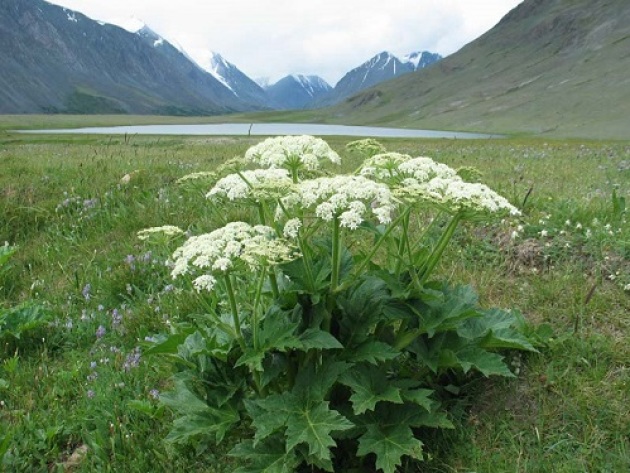
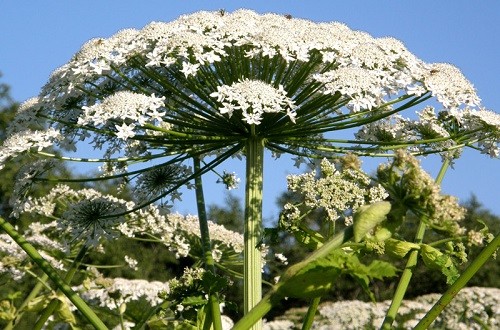
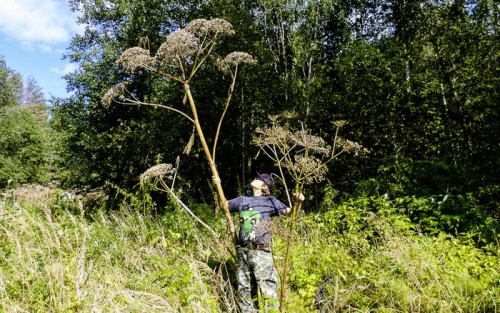
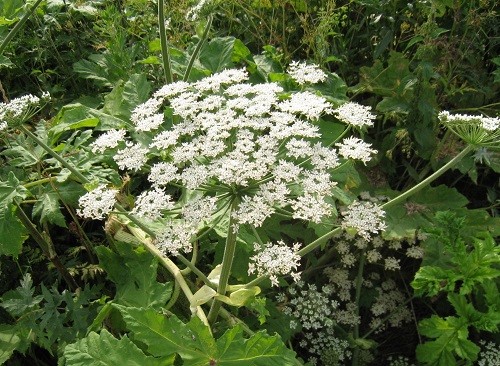
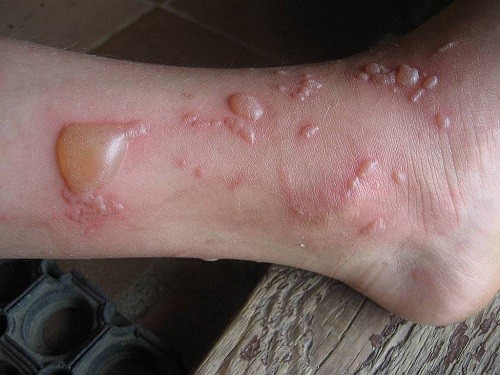
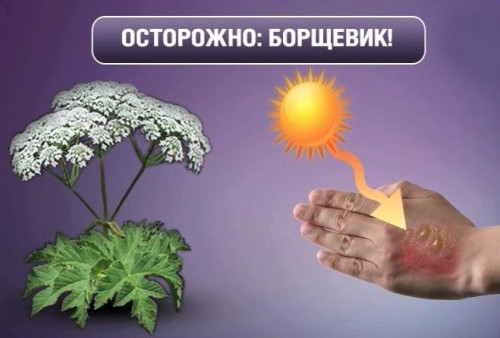
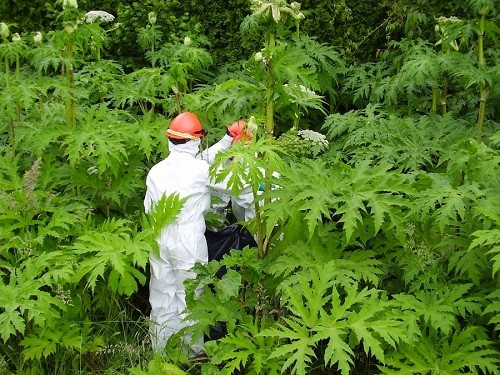
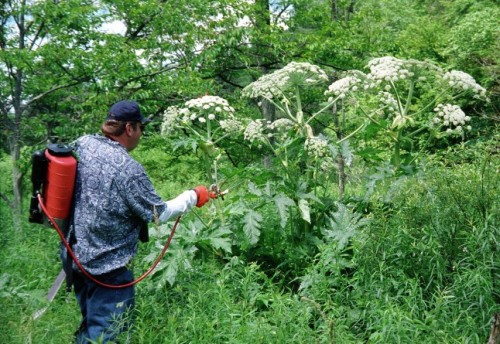
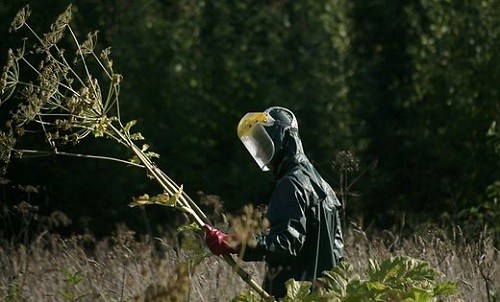
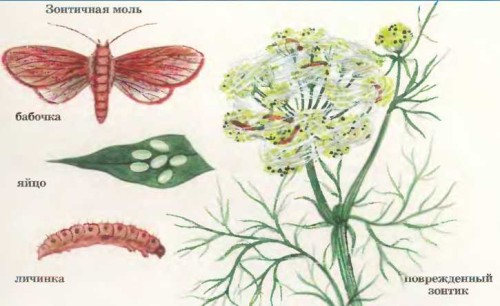
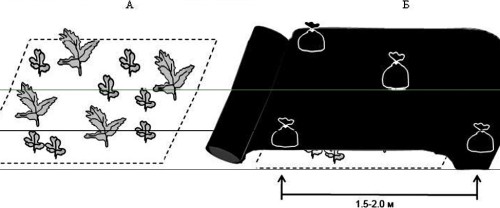












 Start discussion ...
Start discussion ...